文库小学英语教案模板范文
小学英语教育教学教案设计(精选9篇)

小学英语教育教学教案设计(精选9篇)(经典版)编制人:__________________审核人:__________________审批人:__________________编制单位:__________________编制时间:____年____月____日序言下载提示:该文档是本店铺精心编制而成的,希望大家下载后,能够帮助大家解决实际问题。
文档下载后可定制修改,请根据实际需要进行调整和使用,谢谢!并且,本店铺为大家提供各种类型的经典范文,如总结报告、心得体会、应急预案、会议记录、条据书信、合同协议、规章制度、教学资料、作文大全、其他范文等等,想了解不同范文格式和写法,敬请关注!Download tips: This document is carefully compiled by this editor. I hope that after you download it, it can help you solve practical problems. The document can be customized and modified after downloading, please adjust and use it according to actual needs, thank you!Moreover, our store provides various types of classic sample essays, such as summary reports, insights, emergency plans, meeting minutes, evidence letters, contract agreements, rules and regulations, teaching materials, essay summaries, and other sample essays. If you would like to learn about different sample formats and writing methods, please pay attention!小学英语教育教学教案设计(精选9篇)小学英语教育教学教案设计(精选9篇)2024-04-14 12:07:23小学英语教学设计(精选6篇)推荐度:小学英语教学设计范文最新6篇推荐度:热点范文英语(英文:English)是一种西日耳曼语支,最早被中世纪的英国使用,并因其广阔的殖民地而成为世界使用面积最广的语言。
小学英语教案模板(5篇)

小学英语教案模板(5篇)最新小学英语教案模板(5篇)初步了解表示接触的指示用语,能听懂,并按指令做出相应的动作。
你会写教案吗?下面是小编为大家整理的最新小学英语教案模板,希望能够帮助到大家!最新小学英语教案模板篇1教学目标:知识与能力:1、能听懂、会说“How tall are you I’m 1.65meters. I’m taller than this one. Howtall is it”并能在情景中正确运用。
2、能够知道meter的意思能够独立完成let’s try的练习过程与方法:学生能在合作交流中使用新语言进行沟通情感与价值观:培养学生良好的英语学习习惯。
了解基本的计量单位的运用教学重点:掌握句型:How tall are you I’m 1.65meters. I’m taller than this one. How tallis it”教学难点:能在情景中正确运用所学句型并能完成调查表。
教具学具课件准备录音机及磁带、图片、学生自备一张调查表第几课时:2探索流程个性添加(教学反思)1. preparation(预习)1.日常口语练习。
2.复习单词:taller、 longer、 older、 younger 、shorter2. presentation(新课呈现)(1)Let’s try教师播放录音,学生独立完成练习并核对答案(2)Let’s talka.生阅读对话,并解释大意b.教师范读,学生跟读c.分组读,个别读回答问题d.播放录音,学到再次跟读3.practice(练习)(1).T: How tall are you I’m 1.65metres.引导学生回答,并多加练习。
(2).做完后教师出示图片问How tall are you请学生轮流回答。
(3).把图片出示给学生,让他们加强练习。
同桌或小组之间互相练习。
(4).学生两人分角色朗读课文对话。
4.homework(家庭拓展)(1).做本单元A Let’s talk部分的活动手册配套练习。
小学英语全英教案模板-小学全英文教案模板
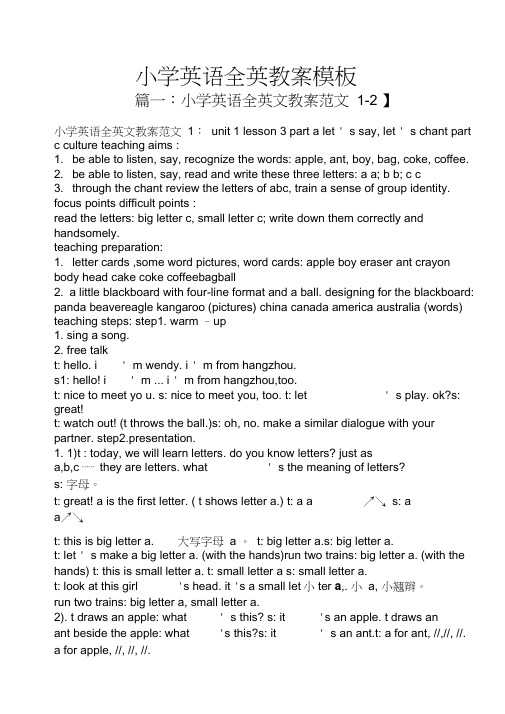
小学英语全英教案模板篇一:小学英语全英文教案范文1-2 】小学英语全英文教案范文1:unit 1 lesson 3 part a let ' s say, let ' s chant partc culture teaching aims :1. be able to listen, say, recognize the words: apple, ant, boy, bag, coke, coffee.2. be able to listen, say, read and write these three letters: a a; b b; c c3. through the chant review the letters of abc, train a sense of group identity. focus points difficult points :read the letters: big letter c, small letter c; write down them correctly and handsomely.teaching preparation:1. letter cards ,some word pictures, word cards: apple boy eraser ant crayon body head cake coke coffeebagball2. a little blackboard with four-line format and a ball. designing for the blackboard: panda beavereagle kangaroo (pictures) china canada america australia (words) teaching steps: step1. warm –up1. sing a song.2. free talkt: hello. i ' m wendy. i ' m from hangzhou.s1: hello! i ' m ... i ' m from hangzhou,too.t: nice to meet yo u. s: nice to meet you, too. t: let ' s play. ok?s: great!t: watch out! (t throws the ball.)s: oh, no. make a similar dialogue with your partner. step2.presentation.1. 1)t : today, we will learn letters. do you know letters? just asa,b,c ⋯⋯they are letters. what ' s the meaning of letters?s: 字母。
小学英语教案模板范文

小学英语教案模板范文《小学英语教案模板范文》
一、教学目标:
1. 能够听、说、读、写26个英文字母。
2. 了解并能正确运用简单的日常用语。
3. 能够在实际情境中进行简单的对话和表达。
二、教学重点:
1. 英文字母的学习和掌握。
2. 日常用语的熟练运用。
三、教学难点:
1. 发音准确性的培养。
2. 词组与句子的准确运用。
四、教学准备:
1. 教师准备26个大英文字母卡片。
2. 学生图片字卡片。
3. 教学磁带。
4. 教学图片。
五、教学过程:
Step 1: Warm-up
教师播放英文字母的发音,并让学生跟读。
Step 2: Presentation
教师出示大英文字母卡片,介绍并讲解英文字母的发音和书写,学生跟读。
Step 3: Practice
教师让学生跟着教学磁带,模仿发音,练习26个英文字母的
发音。
Step 4: Consolidation
教师设计游戏活动,让学生在游戏中巩固英文字母的学习和掌握。
Step 5: Production
教师出示图片,让学生用所学英文字母组成简单的句子,进行表达。
Step 6: Homework
布置作业,要求学生在家里练习26个英文字母的发音和书写,并用英文写一篇简短的日记。
六、教学反思:
本课程以英文字母的学习为主线,通过多种形式的教学手段,激发学生学习英语的兴趣,巩固英文字母的学习,培养学生的英语语感和表达能力。
同时,教师在教学中注重激发学生的学习兴趣和积极性,让学生在轻松愉快的氛围中学习英语。
小学生英语教案范文五篇

【导语】教案是教师为顺利⽽有效地开展教学活动,根据课程标准,教学⼤纲和教科书要求及学⽣的实际情况,以课时或课题为单位,对教学内容、教学步骤、教学⽅法等进⾏的具体设计和安排的⼀种实⽤性教学⽂书。
以下是整理的《⼩学⽣英语教案范⽂五篇》相关资料,希望帮助到您。
1.⼩学⽣英语教案范⽂ 教学⽬的: 1、能听、说、辨认:hellohiname 2、认识与本课有关的⼏个⼈物:DaMing(⼤明)Amy(埃⽶)Sam(⼭姆) 教学重点、难点:单词:hellohiname 句型:Whatsyourname?Mynameis. 教学准备:词汇卡⽚三个头饰 教学过程: ⼀、开始上课 1、因为本单元是开学第⼀个单元,有很多同学对英语⼀⽆所知,所以在教课过程中,尽量使⽤简单的英语⼝语,必要的地⽅⼀定使⽤汉语教学,尽量给学⽣创设⼀个良好的学习环境,教师可以通过⼿势、表情、动作等⽰意学⽣加深理解。
如:说Standup,please和Sitdown,please时,教师可以⽤⼿势:双⼿向前平伸,⼿⼼朝上摆动⽰意学⽣起⽴, 相反表⽰坐下。
.教师⽤英语说:Nowclassbegins.然后借助⼿势让学⽣起⽴,⽤英语向学⽣问好。
T:Goodmorning,class! S:Goodmorning,teacher! 然后⽤英语说:Sitdown,please.并同时做出请学⽣坐下的⼿势。
教师向学⽣解释Goodmorning的意思,并告诉学⽣下午好应说“Goodafternoon”。
⽤⼿势介绍teacher和class这两个词,然后要全班⽤相同的语句来应答。
T:Goodmorning,class!Ss:Goodmorning,teacher!T:Goodafternoon,class!Ss:Goodafternoon,teacher! 反复训练⼏次,直到学⽣练熟为⽌。
教师可以反复重复:Standup.及Sitdown,please.等⽤语,让学⽣们做出相应的动作,直到确信学⽣已经能听懂为⽌。
小学英语教案模板范例
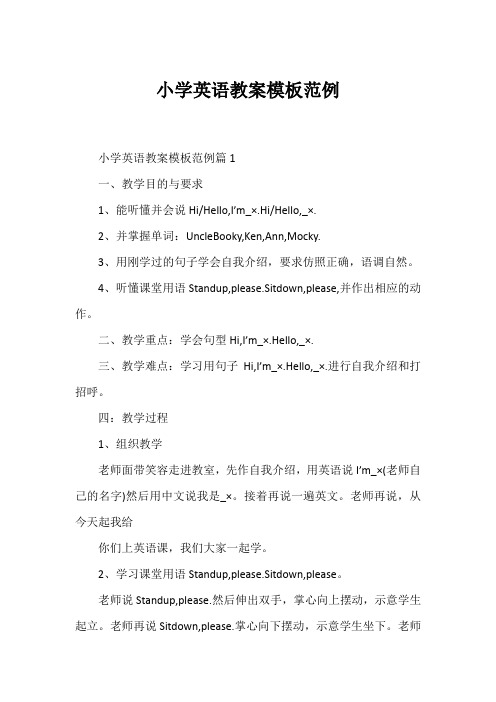
小学英语教案模板范例小学英语教案模板范例篇1一、教学目的与要求1、能听懂并会说Hi/Hello,I’m_×.Hi/Hello,_×.2、并掌握单词:UncleBooky,Ken,Ann,Mocky.3、用刚学过的句子学会自我介绍,要求仿照正确,语调自然。
4、听懂课堂用语Standup,please.Sitdown,please,并作出相应的动作。
二、教学重点:学会句型Hi,I’m_×.Hello,_×.三、教学难点:学习用句子Hi,I’m_×.Hello,_×.进行自我介绍和打招呼。
四:教学过程1、组织教学老师面带笑容走进教室,先作自我介绍,用英语说I’m_×(老师自己的名字)然后用中文说我是_×。
接着再说一遍英文。
老师再说,从今天起我给你们上英语课,我们大家一起学。
2、学习课堂用语Standup,please.Sitdown,please。
老师说Standup,please.然后伸出双手,掌心向上摆动,示意学生起立。
老师再说Sitdown,please.掌心向下摆动,示意学生坐下。
老师走到学生当中,边说边示意。
全班学生做,小组做,最后抽查个别学生做。
接着,老师又站回讲台前,再慢速而准确地说一遍,让学生注意老师发音的口型。
3、学习单词Uncle学习用句型Hi,I’m_×.Hello,_×.进行对话。
(1)老师在讲台前作示范,带表情和手势。
要求学生注意看老师发音的口型和表情。
(2)老师再说I’m_×(老师自己的名字)。
注意夸大口型发出I’m的音给学生听。
让学生仿照发音。
告诉学生意思是“我是”。
让学生在后面接上自己的姓和名,表示“我是_×。
”(3)老师带领学生反复练习I’m的发音。
在基本掌握后,再带领学生操练这个句型,让学生在I’m后面说出自己的名字。
练习两遍后老师在黑板上写出Hi,I’m??这个句型,再教学生读Hi,告诉他们是“喂”的意思。
小学英语教案20篇模板

小学英语教案20篇模板小学英语教育是学习英语的起点,也是英语教学中最重要的一环。
为了帮助小学英语教师更好的开展教学工作,不断提高学生的英语水平,很多教师都会编写英语教案。
在这里为大家提供20 篇模板,希望对小学英语教师有所帮助。
1. Title: My FamilyObjective: Students will be able to introduce their family members and talk about their family using "This is my...".2. Title: My FriendsObjective: Students will be able to introduce their friends and talk about their interests and hobbies using "He/She likes/loves..."3. Title: Daily RoutineObjective: Students will be able to describe their daily routines using "I wake up, brush my teeth, have breakfast, go to school..."4. Title: TimeObjective: Students will be able to tell the time using "It's...o'clock".5. Title: FoodObjective: Students will be able to describe different types of food and talk about their favorite foods using "I like...".6. Title: ColorsObjective: Students will be able to identify and name different colors using "What color is this?"7. Title: AnimalsObjective: Students will be able to identify and name different animals and talk about their habitats using "This is a...It lives in..."8. Title: SeasonsObjective: Students will be able to identify and name the four seasons and talk about the weather using "It's hot/cold, sunny/rainy...".9. Title: ClothesObjective: Students will be able to identify and name different clothing items and talk about what they are wearing using "I am wearing a...".10. Title: Days of the WeekObjective: Students will be able to identify and name the days of the week using "Today is...".11. Title: Months of the YearObjective: Students will be able to identify and name the months of the year using "This month is...".12. Title: WeatherObjective: Students will be able to describe the weather using "It's hot/cold, sunny/rainy...".13. Title: Family MembersObjective: Students will be able to identify and name different family members and talk about their relationships using "He/She is my...".14. Title: JobsObjective: Students will be able to identify and name different jobs and talk about what they want to be when they grow up using "I want to be a...".15. Title: EmotionsObjective: Students will be able to identify and name different emotions and talk about how they feel using "I am happy/sad/angry...".16. Title: School SubjectsObjective: Students will be able to identify and name different school subjects using "I like/dislike...".17. Title: NumbersObjective: Students will be able to identify and name numbers from one to ten using "One, two, three..."18. Title: The AlphabetObjective: Students will be able to identify and name the letters of the alphabet using "A, B, C...".19. Title: TransportObjective: Students will be able to identify and name different modes of transport and talk about how they go to school using "I go to school by...".20. Title: Places in the CityObjective: Students will be able to identify and name different places in the city and talk about their favorite places using "I like to go to the...".以上是20 篇小学英语教案模板,每个课程的目标清晰明确,教材内容深入浅出,教案结构也清晰合理。
小学英语教案模板英文范文
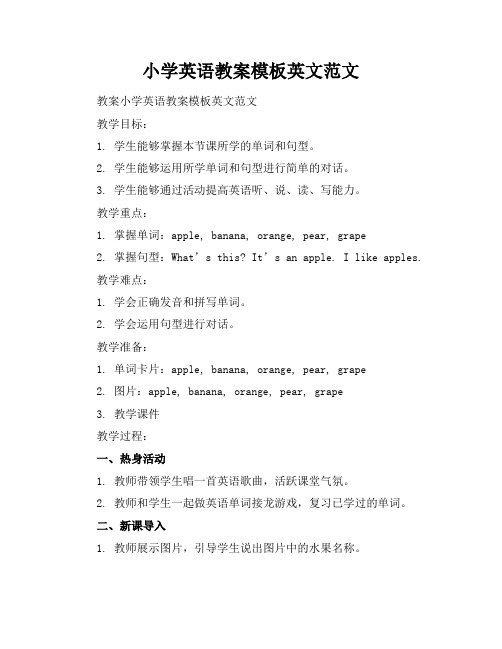
小学英语教案模板英文范文教案小学英语教案模板英文范文教学目标:1. 学生能够掌握本节课所学的单词和句型。
2. 学生能够运用所学单词和句型进行简单的对话。
3. 学生能够通过活动提高英语听、说、读、写能力。
教学重点:1. 掌握单词:apple, banana, orange, pear, grape2. 掌握句型:What’s this? It’s an apple. I like apples.教学难点:1. 学会正确发音和拼写单词。
2. 学会运用句型进行对话。
教学准备:1. 单词卡片:apple, banana, orange, pear, grape2. 图片:apple, banana, orange, pear, grape3. 教学课件教学过程:一、热身活动1. 教师带领学生唱一首英语歌曲,活跃课堂气氛。
2. 教师和学生一起做英语单词接龙游戏,复习已学过的单词。
二、新课导入1. 教师展示图片,引导学生说出图片中的水果名称。
2. 教师板书单词:apple, banana, orange, pear, grape,并带领学生跟读。
三、新课讲解1. 教师讲解单词的发音和拼写,学生跟读并模仿。
2. 教师引导学生用句型:What’s this? It’s an apple. I like apples. 进行对话。
四、课堂活动1. 小组活动:学生分成小组,用所学单词和句型进行对话。
2. 游戏活动:教师带领学生玩“水果猜猜乐”游戏,学生通过听音猜水果名称。
五、巩固练习1. 教师发放单词卡片,学生分组进行单词拼写比赛。
2. 教师发放图片,学生分组进行句型对话练习。
六、课堂小结1. 教师带领学生回顾本节课所学的单词和句型。
2. 学生分享学习心得,教师给予鼓励和指导。
七、布置作业1. 让学生回家后复习本节课所学的单词和句型。
2. 让学生用所学句型写一篇短文,描述自己喜欢的水果。
教学反思:本节课通过图片、游戏、对话等多种形式,激发了学生的学习兴趣,提高了学生的英语听、说、读、写能力。
小学的教案模板范文小学英语教案范文
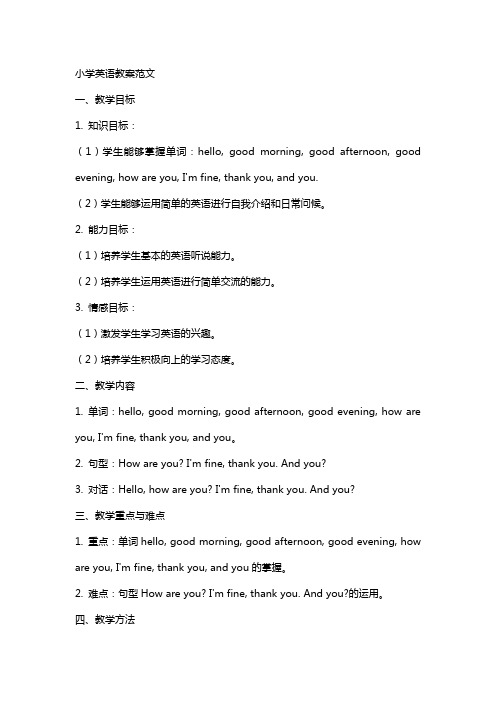
小学英语教案范文一、教学目标1. 知识目标:(1)学生能够掌握单词:hello, good morning, good afternoon, good evening, how are you, I'm fine, thank you, and you.(2)学生能够运用简单的英语进行自我介绍和日常问候。
2. 能力目标:(1)培养学生基本的英语听说能力。
(2)培养学生运用英语进行简单交流的能力。
3. 情感目标:(1)激发学生学习英语的兴趣。
(2)培养学生积极向上的学习态度。
二、教学内容1. 单词:hello, good morning, good afternoon, good evening, how are you, I'm fine, thank you, and you。
2. 句型:How are you? I'm fine, thank you. And you?3. 对话:Hello, how are you? I'm fine, thank you. And you?三、教学重点与难点1. 重点:单词hello, good morning, good afternoon, good evening, how are you, I'm fine, thank you, and you的掌握。
2. 难点:句型How are you? I'm fine, thank you. And you?的运用。
四、教学方法1. 情境教学法:通过设定日常生活中的情境,让学生在实际语境中学习英语。
2. 游戏教学法:通过趣味性游戏,激发学生的学习兴趣,提高学生的参与度。
3. 互动教学法:引导学生积极参与课堂互动,提高学生的口语表达能力。
五、教学步骤1. 热身活动(5分钟)(1)教师与学生用中文进行简单的自我介绍。
(2)学生相互之间用中文进行问候。
2. 引入新课(10分钟)(1)教师展示单词卡片,引导学生跟读单词。
小学英语教案范本5篇

小学英语教案范本5篇英语是联合国、欧洲联盟以及很多其他世界和区域国际组织的官方语言之一。
下面是我给大家整理的学校英语教案范本,仅供参考盼望能够关心到大家。
学校英语教案范本篇1一、教学目标:1、把握there be结构所表达的意义。
2、能听懂和看懂包含there be句型的简短对话。
3、能运用学过词汇和there be句型来简洁描述一下某处有某物。
二、重点难点:there be句型的确定式、否定式一般疑问句及其回答方式。
三、教学过程:1、there be概念。
there be ...句型,表示的是“存在”,“某地有某人或某物”,其结构为there be(is,are)+某物/某人+某地。
2、be动词的用法。
单数名词和不行数名词用is,复数用are.3、there is的句子结构:there is a book on the desk.there is some water in the bottle. 5、there are的句子结构:there are some pictures on the wall. 6、练一练。
7、there be句型就近原则及练习。
四、小结及there be口诀。
学校英语教案范本篇2单元教材分析单元学情分析本单元以过去和现在为话题,重点学习表示过去的时间状语、学校设施和部分动词及动词短语。
本单元以同学的实际状况动身,通过说唱歌谣、小组合作等形式使同学处于轻松、欢乐、趣味十足的学习氛围。
单元教学目标:1、听说认读star,easy,race,felt,trip,woke,会听说读写gym,ago,cycling,badminton.2、能够娴熟运用There be句型描述过去的事情和现在的事情。
3、能够把握询问某人的变化的句型。
课时教学设计课题:Unit 4 A Lets learn备课人:上课人:教学目标:1、听说认读单词:dining hall,gym,grass,…years ago,…months ago,last year,lastmonth.2、学习句型:There was/were…We didn’t have…及其一般过去时态的详细运用。
小学英语教案万能模板【优秀10篇】

小学英语教案万能模板【优秀10篇】新标准小学英语第四册Module1 Unit1教案篇一module1 unit 1教学目标:1、掌握以下单词的读写,并能熟练使用:nice,a bit,shy,clever,naughty,2、熟练使用句子:this is . he/she is very +adj.3、会用所学的形容词语描述自己、家人和朋友。
教学重难点:1、单词的读音、拼写和运用。
2、形容词在句子中的正确使用。
教学过程:一、greetings.二、duty report.三、warming-up and reviewing.1、sing songs.2、ask and answer.如:t: thin. s: fat.复习(fat,thin,old, young,tall,short,bit,little/small)3. (出示图片)t:this is my friend ms smart. she’s a nice teacher. she’s tall and thin. à 引出课题module 1 friends unit 1 she’s a nice teacher.四:presentation1、呈现新单词:t: look, this is my family. this is my father, he is very nice. this is my mother, she is nice too, but she is a bit shy. this is my little sister, she is thin and very clever. this is my cousin, he is very naughty . we’re happy in the spring festival. (教师把绘制的“全家福”图画贴在黑板上。
)(教读新单词)nice.强调“i”的发音。
小学英语教案模板5篇

小学英语教案模板5篇学校英语教案模板篇1教学内容:Part B and D of Unit 11 A boy and a girl, Fun with English.教学目标:1、 Enable the Ss to understand, read and say the new words “boy, girl, Chinese, thin, fat, tall, short.”2、 Enable the Ss to use the sentence in their daily life.3、Develop the Ss' abilities of listening, speaking, and writing English.4、 Train the Ss' abilities of cooperation.重点难点:1、 The pronunciation of some new words “girl, thin, tall, small”2、 Enable the Ss to say and use the sentences“My name is …I'm …”to introduce themselves to others.教学预备:CAI、tape、recorder.教学方法:Communicational Approach教学过程:Step1、 Warm—up1、 Sing a song “Hello”。
2、 Free talkT: This is … Her name is Helen.What's your name? Nice to meet you.Step2、 Presentation & practice1、 Present and practice the new sentence “My name is …”2 T: Do you want to know my name?Ss: …T: My name is …(T presents the new sentence “My name is …”)T: My name is Zhu Xiaoyan. How about your name?S: My name is ……2、 Present and practice the new words “boy, girl, Chinese, I'm from…”T: (Show the Ss the picture of Liu Tao) Look, this is …Ss: Liu Tao. T: This is Liu Tao. So we know his name is Liu Tao.T: How about his sex?T: What's this?T: This is a Chinese flag. (Present and teach the word “boy, Chinese”)T: (point to one of them) this is a … Liu Tao is a Chinese boy.How about...? T: (point to one of them)… is a …T: Who's she? (Present the new word “girl”)T: Miss Zhu is a girl. I'm a Chinese girl. And I'm from Rudong.T: Where are you from? …(Present the sentence “I'm from…”)Do you know where is Liu Tao from?3、Present and practice the new words “fat, thin, tall, short”T: We know Liu Tao is from Shanghai. Shanghai is a beautiful city. Let's go to Shanghai.Ss: OK. T: Where is it?Ss: It's a zoo.T: Let's see what are in the zoo. (Present some pictures of animals)T: Look, this is a …(monkey) And this is a monkey. (Present and practice the word “fat, thin”)T: (Present the picture of LiuTao and Yao Ming) This is .T: Yao Ming is . (Present and practice the new word “tall, short”)4、 Present and read the textT: Now, how much do you know about Liu Tao? Say it out! …T: Let's read and learn Liu Tao's self-introduction.(Ask the Ss to read after the tape )T: Close your books, please. Look , This is Liu Tao's self-introduction, and this is me, can you help me correct it? (Ask the Ss to correct the self-introduction, and learn the example.)Step3、ConsolidationT: Now, boys and girls.Try to introduce yourselves.You have 30 seconds to do it.Step4、 Homework1、 Make your self-introduction card.2、 Introduce yourselves to five people and ask them to sign on the back of your introduction cards.板书设计:Unit 11 A boy and a girlMy name is … I'm aChinese… boy girl I'm from…I'm …(年龄) tall shortI'm …(特征) fat thin学校英语教案模板篇2一、教学内容1.词汇(略)。
小学英语教案全英文版【三篇】
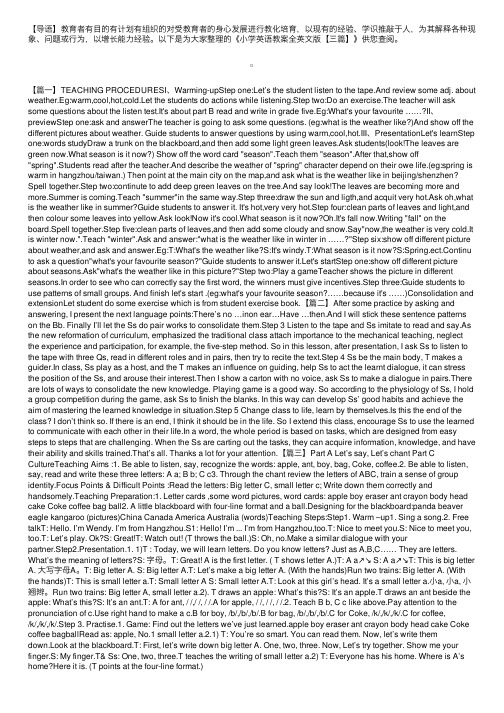
【导语】教育者有⽬的有计划有组织的对受教育者的⾝⼼发展进⾏教化培育,以现有的经验、学识推敲于⼈,为其解释各种现象、问题或⾏为,以增长能⼒经验。
以下是为⼤家整理的《⼩学英语教案全英⽂版【三篇】》供您查阅。
【篇⼀】TEACHING PROCEDURESI、Warming-upStep one:Let’s the student listen to the tape.And review some adj. about weather.Eg:warm,cool,hot,cold.Let the students do actions while listening.Step two:Do an exercise.The teacher will ask some questions about the listen test.It's about part B read and write in grade five.Eg:What's your favourite (II)previewStep one:ask and answerThe teacher is going to ask some questions. (eg:what is the weather like?)And show off the different pictures about weather. Guide students to answer questions by using warm,cool,hot.III、PresentationLet's learnStep one:words studyDraw a trunk on the blackboard,and then add some light green leaves.Ask students(look!The leaves are green now.What season is it now?) Show off the word card "season".Teach them "season".After that,show off "spring".Students read after the teacher.And describe the weather of "spring" character depend on their owe life.(eg:spring is warm in hangzhou/taiwan.) Then point at the main city on the map,and ask what is the weather like in beijing/shenzhen? Spell together.Step two:continute to add deep green leaves on the tree.And say look!The leaves are becoming more and more.Summer is coming.Teach "summer"in the same way.Step three:draw the sun and ligth,and acquit very hot.Ask oh,what is the weather like in summer?Guide students to answer it. It's hot,very very hot.Step four:clean parts of leaves and light,and then colour some leaves into yellow.Ask look!Now it's cool.What season is it now?Oh.It's fall now.Writing "fall" on the board.Spell together.Step five:clean parts of leaves,and then add some cloudy and snow.Say"now,the weather is very cold.It is winter now.".Teach "winter".Ask and answer:"what is the weather like in winter in ……?"Step six:show off different picture about weather,and ask and answer.Eg:T:What's the weather like?S:It's windy.T:What season is it now?S:Spring.ect.Continu to ask a question"what's your favourite season?"Guide students to answer it.Let's startStep one:show off different picture about seasons.Ask"what's the weather like in this picture?"Step two:Play a gameTeacher shows the picture in different seasons.In order to see who can correctly say the first word, the winners must give incentives.Step three:Guide students to use patterns of small groups. And finish let's start .(eg:what's your favourite season?……because it's ……)Consolidation and extensionLet student do some exercise which is from student exercise book.【篇⼆】After some practice by asking and answering, I present the next language points:There’s no …inon ear…Have …then.And I will stick these sentence patterns on the Bb. Finally I’ll let the Ss do pair works to consolidate them.Step 3 Listen to the tape and Ss imitate to read and say.As the new reformation of curriculum, emphasized the traditional class attach importance to the mechanical teaching, neglect the experience and participation, for example, the five-step method. So in this lesson, after presentation, I ask Ss to listen to the tape with three Qs, read in different roles and in pairs, then try to recite the text.Step 4 Ss be the main body, T makes a guider.In class, Ss play as a host, and the T makes an influence on guiding, help Ss to act the learnt dialogue, it can stress the position of the Ss, and arouse their interest.Then I show a carton with no voice, ask Ss to make a dialogue in pairs.There are lots of ways to consolidate the new knowledge. Playing game is a good way. So according to the physiology of Ss, I hold a group competition during the game, ask Ss to finish the blanks. In this way can develop Ss’ good habits and achieve the aim of mastering the learned knowledge in situation.Step 5 Change class to life, learn by themselves.Is this the end of the class? I don’t think so. If there is an end, I think it should be in the life. So I extend this class, encourage Ss to use the learned to communicate with each other in their life.In a word, the whole period is based on tasks, which are designed from easy steps to steps that are challenging. When the Ss are carting out the tasks, they can acquire information, knowledge, and have their ability and skills trained.That’s all. Thanks a lot for your attention.【篇三】Part A Let’s say, Let’s chant Part C CultureTeaching Aims :1. Be able to listen, say, recognize the words: apple, ant, boy, bag, Coke, coffee.2. Be able to listen, say, read and write these three letters: A a; B b; C c3. Through the chant review the letters of ABC, train a sense of group identity.Focus Points & Difficult Points :Read the letters: Big letter C, small letter c; Write down them correctly and handsomely.Teaching Preparation:1. Letter cards ,some word pictures, word cards: apple boy eraser ant crayon body head cake Coke coffee bag ball2. A little blackboard with four-line format and a ball.Designing for the blackboard:panda beaver eagle kangaroo (pictures)China Canada America Australia (words)Teaching Steps:Step1. Warm –up1. Sing a song.2. Free talkT: Hello. I’m Wendy. I’m from Hangzhou.S1: Hello! I’m ... I’m from Hangzhou,too.T: Nice to meet you.S: Nice to meet you, too.T: Let’s play. Ok?S: Great!T: Watch out! (T throws the ball.)S: Oh, no.Make a similar dialogue with yourpartner.Step2.Presentation.1. 1)T : Today, we will learn letters. Do you know letters? Just as A,B,C…… They are letters. What’s the meaning of letters?S: 字母。
小学英语教学教案七篇模板
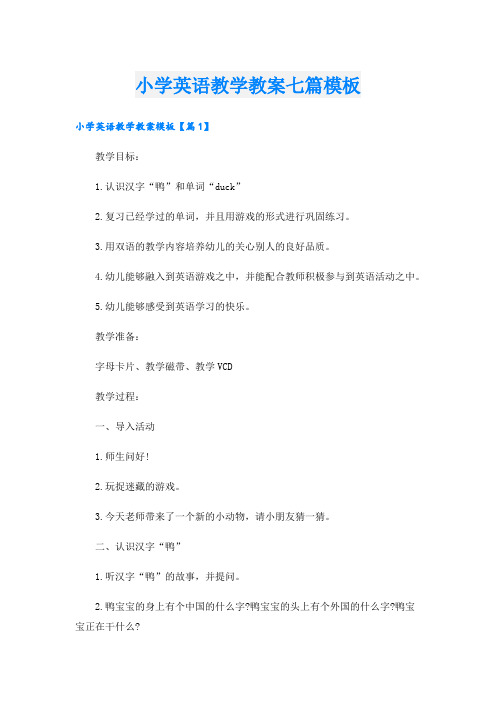
小学英语教学教案七篇模板小学英语教学教案模板【篇1】教学目标:1.认识汉字“鸭”和单词“duck”2.复习已经学过的单词,并且用游戏的形式进行巩固练习。
3.用双语的教学内容培养幼儿的关心别人的良好品质。
4.幼儿能够融入到英语游戏之中,并能配合教师积极参与到英语活动之中。
5.幼儿能够感受到英语学习的快乐。
教学准备:字母卡片、教学磁带、教学VCD教学过程:一、导入活动1.师生问好!2.玩捉迷藏的游戏。
3.今天老师带来了一个新的小动物,请小朋友猜一猜。
二、认识汉字“鸭”1.听汉字“鸭”的故事,并提问。
2.鸭宝宝的身上有个中国的什么字?鸭宝宝的头上有个外国的什么字?鸭宝宝正在干什么?3.师生一起表演这个故事。
三、认识单词“duck”1.听单词的故事,并提问:(1)鸭宝宝从农场回来后从谁的头上飞了过去?(2)鸭宝宝飞到什么里面把水喝完了?(3)谁看见了很生气地批评了鸭宝宝?(4)小朋友,你们认为鸭宝宝这样做对吗?2.集体观看单词儿歌动画片。
3.表演单词的字母组成故事。
四、听音拍手游戏。
小学英语教学教案模板【篇2】教学重点:1.掌握字母的发音和书写。
2.巩固数字30-60的拼读。
教学难点:1.Jj, Gg; Bb, Dd; Ii, Rr; Mm, Nn几组字母在发音上易混淆。
2.B, d; l, j; p, q; u, v在书写时易写错。
3.Sing and read中出现了三个新单词:jet, sugar, X’mas.要让学生做到能认读。
4.Let’s practise中两道加法题的结果出现了55、60,而前面只学到50。
教具准备:1.字母卡、加法算式卡2.有关学习物品的图片或实物。
3.Read and say部分的自制课件。
4.教材相配套的的录音带教学过程:(一)热身/复习(Warm-up/Revision)1.复习第二册教材第65页的Let’s chant。
2.做“抢读字母”的游戏。
这是一个训练学生认读字母的游戏,教师将全班分成若干小组,然后逐个出示字母卡片,学生们举手抢答,教师让最先举手的学生读出该字母,读对的给该组记10分,最后得分最多的组为优胜。
中小学英语教案模板【优秀6篇】
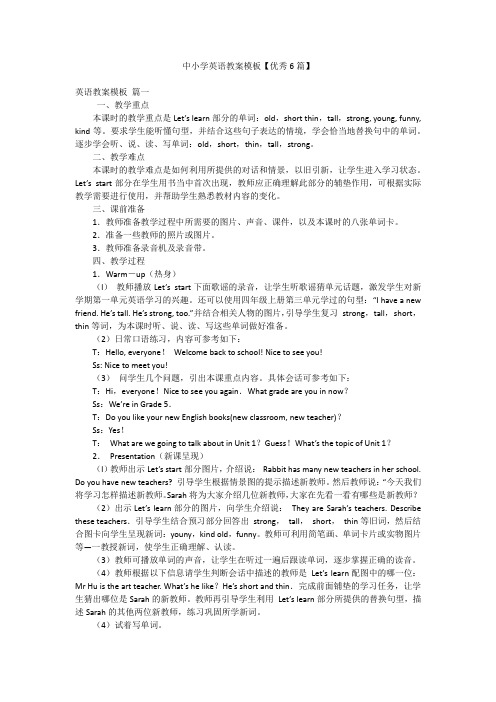
中小学英语教案模板【优秀6篇】英语教案模板篇一一、教学重点本课时的教学重点是Let’s learn部分的单词:old,short thin,tall,strong, young, funny, kind等。
要求学生能听懂句型,并结合这些句子表达的情境,学会恰当地替换句中的单词。
逐步学会听、说、读、写单词:old,short,thin,tall,strong。
二、教学难点本课时的教学难点是如何利用所提供的对话和情景,以旧引新,让学生进入学习状态。
Let’s start部分在学生用书当中首次出现,教师应正确理解此部分的辅垫作用,可根据实际教学需要进行使用,并帮助学生熟悉教材内容的变化。
三、课前准备1.教师准备教学过程中所需要的图片、声音、课件,以及本课时的八张单词卡。
2.准备一些教师的照片或图片。
3.教师准备录音机及录音带。
四、教学过程1.Warm-up(热身)(l)教师播放Let’s start下面歌谣的录音,让学生听歌谣猜单元话题,激发学生对新学期第一单元英语学习的兴趣。
还可以使用四年级上册第三单元学过的句型:“I have a new friend. He’s tall. He’s strong, too.”并结合相关人物的图片,引导学生复习strong,tall,short,thin等词,为本课时听、说、读、写这些单词做好准备。
(2)日常口语练习,内容可参考如下:T:Hello, everyone!Welcome back to school! Nice to see you!Ss: Nice to meet you!(3)问学生几个问题,引出本课重点内容。
具体会话可参考如下:T:Hi,everyone!Nice to see you again.What grade are you in now?Ss:We’re in Grade 5.T:Do you like your new English books(new classroom, new teacher)?Ss:Yes!T:What are we going to talk about in Unit 1?Guess!What’s the topic of Unit 1?2.Presentation(新课呈现)(l)教师出示Let’s start部分图片,介绍说:Rabbit has many new teachers in her school. Do you have new teachers? 引导学生根据情景图的提示描述新教师。
人教版小学英语教案模板(通用10篇)
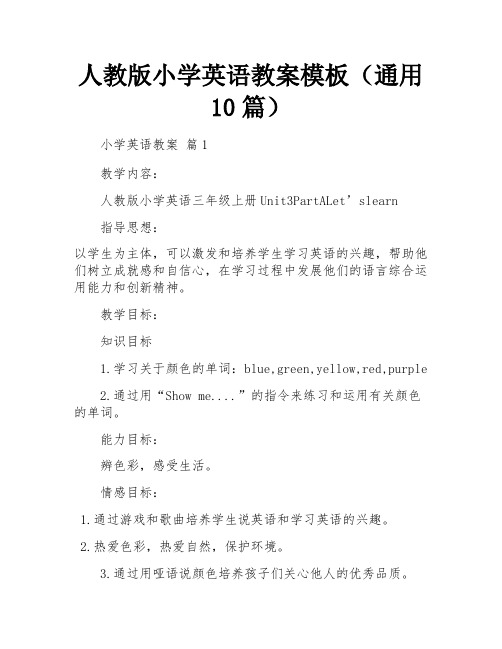
人教版小学英语教案模板(通用10篇)小学英语教案篇1教学内容:人教版小学英语三年级上册Unit3PartALet’slearn指导思想:以学生为主体,可以激发和培养学生学习英语的兴趣,帮助他们树立成就感和自信心,在学习过程中发展他们的语言综合运用能力和创新精神。
教学目标:知识目标1.学习关于颜色的单词:blue,green,yellow,red,purple2.通过用“Show me....”的指令来练习和运用有关颜色的单词。
能力目标:辨色彩,感受生活。
情感目标:1.通过游戏和歌曲培养学生说英语和学习英语的兴趣。
2.热爱色彩,热爱自然,保护环境。
3.通过用哑语说颜色培养孩子们关心他人的优秀品质。
教学重、难点:1.听,说,读五个颜色单词。
2.会说唱Let’s do,并会听音做出相应的反应。
教具准备:1.教师准备blue,green,yellow,red,purple的单词卡片和颜色卡片。
老师和学生准备红色、黄色、蓝色、绿色和紫色的蜡笔。
3.教师准备色彩教学课件。
4.老师把学生学过的文具准备好,放在书包里。
教学教程:Warm-up:(1)师生之间相互问候:T:Good morning/Good afternoon/Hello,boys and girls.S:Good morning/Good afternoon/Hello,teacher/....T:How are you?S:Fine,than kyou./I’mfine,thank you/....(2)游戏T:Let’s playa game,OK?S:OK.“猜一猜”的游戏。
将学生学过的文具放入书包中,让学生摸一摸,猜一猜。
从而复习学过的文具词。
【说明:“猜一猜”的游戏能调动学生大脑中所有相关记忆,使学生回忆起所有知道的有关文具的单词。
】(3)课件出示学过的文具用品:卷笔刀(红色),钢笔(绿色),铅笔盒(蓝色),书(黄),书包(绿色),蜡笔(紫色)。
小学英语教案模板范文5篇
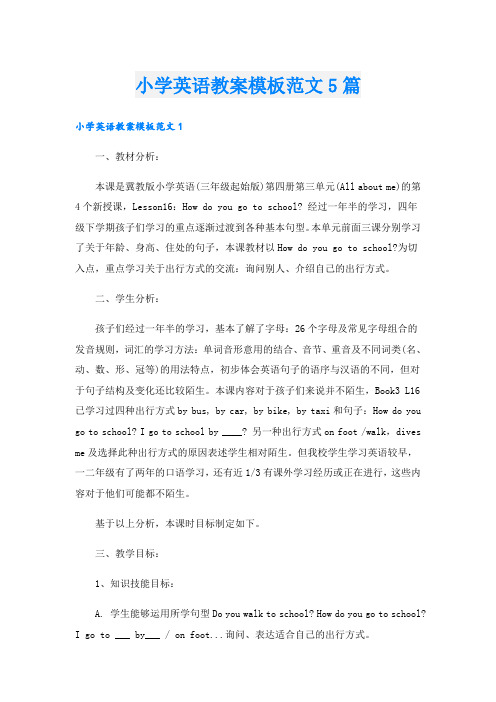
小学英语教案模板范文5篇小学英语教案模板范文1一、教材分析:本课是冀教版小学英语(三年级起始版)第四册第三单元(All about me)的第4个新授课,Lesson16:How do you go to school? 经过一年半的学习,四年级下学期孩子们学习的重点逐渐过渡到各种基本句型。
本单元前面三课分别学习了关于年龄、身高、住处的句子,本课教材以How do you go to school?为切入点,重点学习关于出行方式的交流:询问别人、介绍自己的出行方式。
二、学生分析:孩子们经过一年半的学习,基本了解了字母:26个字母及常见字母组合的发音规则,词汇的学习方法:单词音形意用的结合、音节、重音及不同词类(名、动、数、形、冠等)的用法特点,初步体会英语句子的语序与汉语的不同,但对于句子结构及变化还比较陌生。
本课内容对于孩子们来说并不陌生,Book3 L16已学习过四种出行方式by bus, by car, by bike, by taxi和句子:How do you go to school? I go to school by ____? 另一种出行方式on foot /walk,dives me及选择此种出行方式的原因表述学生相对陌生。
但我校学生学习英语较早,一二年级有了两年的口语学习,还有近1/3有课外学习经历或正在进行,这些内容对于他们可能都不陌生。
基于以上分析,本课时目标制定如下。
三、教学目标:1、知识技能目标:A. 学生能够运用所学句型Do you walk to school? How do you go to school?I go to ___ by___ / on foot...询问、表达适合自己的出行方式。
B. 学生知道句子的变化是和人称有关系的,并能尝试运用所学句子介绍和询问他人的出行方式:Does he/she walk to school? How dooes he/she go to school? He/she goes to school by___ / on foot...2、文化目标:尝试了解不同地区人们选择不同出行方式:山区孩子、牧民(草原)、江南居民及西方国家等。
小学英语教案全英文版(优秀13篇)
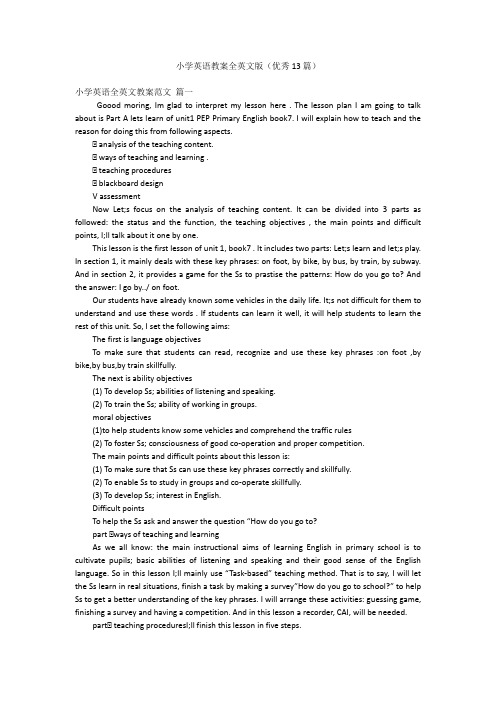
小学英语教案全英文版(优秀13篇)小学英语全英文教案范文篇一Goood moring, Im glad to interpret my lesson here . The lesson plan I am going to talk about is Part A lets learn of unit1 PEP Primary English book7. I will explain how to teach and the reason for doing this from following aspects.Ⅰ analysis of the teaching content.Ⅰ ways of teaching and learning .Ⅰ teaching proceduresⅠ blackboard designV assessmentNow Let;s focus on the analysis of teaching content. It can be divided into 3 parts as followed: the status and the function, the teaching objectives , the main points and difficult points, I;ll talk about it one by one.This lesson is the first lesson of unit 1, book7 . It includes two parts: Let;s learn and let;s play. In section 1, it mainly deals with these key phrases: on foot, by bike, by bus, by train, by subway. And in section 2, it provides a game for the Ss to prastise the patterns: How do you go to? And the answer: I go by../ on foot.Our students have already known some vehicles in the daily life. It;s not difficult for them to understand and use these words . If students can learn it well, it will help students to learn the rest of this unit. So, I set the following aims:The first is language objectivesTo make sure that students can read, recognize and use these key phrases :on foot ,by bike,by bus,by train skillfully.The next is ability objectives(1) To develop Ss; abilities of listening and speaking.(2) To train the Ss; ability of working in groups.moral objectives(1)to help students know some vehicles and comprehend the traffic rules(2) To foster Ss; consciousness of good co-operation and proper competition.The main points and difficult points about this lesson is:(1) To make sure that Ss can use these key phrases correctly and skillfully.(2) To enable Ss to study in groups and co-operate skillfully.(3) To develop Ss; interest in English.Difficult pointsTo help the Ss ask and answer the question “How do you go to?part Ⅰways of teaching and learningAs we all know: the main instructional aims of learning English in primary school is to cultivate pupils; basic abilities of listening and speaking and their good sense of the English language. So in this lesson I;ll mainly use “Task-based” teaching method. That is to say, I will let the Ss learn in real situations, finish a task by making a survey”How do you go to school?” to help Ss to get a better understanding of the key phrases. I will arrange these activities: guessing game, finishing a survey and having a competition. And in this lesson a recorder, CAI, will be needed.partⅠ teaching proceduresI;ll finish this lesson in five steps.step1 lead--in activitiesI will begin my class with drawing and guessing game, just like this : I show students some vehicles such as bike ,bus ,jeep which they learned before by Stick Figures and ask them guess what;s it.Purpose: It is important to form a better English learning surrounding for the Ss by guessing game. and at the same time it provides situations to review learned knowledge for the next step.step2 prestentationNow I;ll mainly talk about this step.1、first there is a Free talk between T and Ss. For example: I show many pictures of beautiful cities and ask students some questions, such as do you like this city?where do you want to go ?and help Ss to answer them with by train ,by plane,by ship.By the way, I show the picture of a school, and say“ I go to schiool by bus” ,Ss read this sentence. do the actions and ask how do you go to school?,show many pictures of tools such as ,on foot by bike ,by bus to help students answer my question one by one.To present the key structures one by one is much easier for the Ss to learn and grasp the meanings.2 With the help of the CAI I set a situation to help Ss understand the way of using these key phrases:A boy is coming, who is going to school. He says: I go to school byThen play the sounds of bus, bike ask students to listen carefully and tell “I go to school by according to the different sounds, by the way , I present another new phrases:by subwayPurpose:Make Ss use these new phrases with sentence structures, to help Ss use the language in a real situation.step3 practise3 I order to make every student read these new phrases correctly, I design a drill in this step,I show cards as soon as possible ,students should read the words quickly and spell them. Then I ask How do you go to school?students answer I go to ......also I will quicken the speed to ask .The purpose is to draw the whole studentsattention to the spelling of the words4 After this, I ask Ss to do Lets play in fours. They use places cards and vehicle cards, ask and answer:How do you go to ? I go to by”5, If Ss can ask and answer expertly, I will ask them to make a short dialogue.the purpose of this is to help students to learn those sentenses through a ture situation and make the dialogues in order to check if Ss can usse these key prases、sentences structures skillfullystep 4 consolidationlet students do a survey about how do you go to school?and the table like this :write down names and tools another Ss chooseTask-based teaching method is used here to develop Ss; ability of ; communication and also their ability of co-operation will be well trained.step 5 homeworkask students to collect other kinds of transport tools through the library ,computer.the purpose of this is to stimulate the interest of learning english and to wide the studentsknowledgestep6 blackboard designmy blackboard design like this :on the left Ishow the phrases:on foot,by bus.......on the right there are many sentences:how do you go to school?I go to ......step 7 assessmentdue to the studentsage ,I make every students work in class through many activities in order to stimulate the studentsinterest and provide they a wide thinking room. I make students learn this lesson very well through desiring scene statuesthats all,thank you for your listening !Unit 1 Lesson 篇二Part A Let;s say, Let;s chant Part C CultureTeaching Aims :1、Be able to listen, say, recognize the words: apple, ant, boy, bag, Coke, coffee.2、Be able to listen, say, read and write these three letters: A a; B b; C c3、Through the chant review the letters of ABC, train a sense of group identity.Focus Points amp; Difficult Points :Read the letters: Big letter C, small letter c; Write down them correctly and handsomely.Teaching Preparation:1、Letter cards ,some word pictures, word cards: apple boy eraser ant crayon body head cake Coke coffee bag ball2、A little blackboard with four-line format and a ball.Designing for the blackboard:panda beaver eagle kangaroo (pictures)China Canada America Australia (words)Teaching Steps:Step1. Warm ndash;up1、Sing a song.2、Free talkT: Hello. I;m Wendy. I;m from Hangzhou.S1: Hello! I;m 。
小学英语课英语教案模板(共7篇)

小学英语课英语教案模板(共7篇)少儿英语教案模板一、TeachingDemandandAim(教学目标)二、Teachingimportantanddifficultpoint(教学重点)1、word2、entence3、grammar三、TeachingAid(教具)四、Teachingprocedure(教学过程)Greeting(问候)warmup(热身)Review(复习)NewLeon(新课)StepOne:StepTwo:StepThree:Followup(叮咛)五、Homework(作业布置)作业的布置一、书面作业1、每节课后教师可适当选择课后习题(书本或课外参考书)及字母作业。
2、低年纪的孩子适合听磁带读课文、画图、连线、写字母等简单作业;每学期两次测试:半期考和期末考试。
3、高年纪的孩子要求抄单词、背单词、背课文等书面作业;每节课前可做适当的听写练习;每个月可做适当的单元测试;期间两次大考:半期考和期末考。
二、磁带作业1、适时布置(条件允许可每周一次):将本周学习的内容录进磁带,下周上交。
2、录制要求:首先让学生和老师打招呼,接着报朗诵单元,然后录作业内容,最后与老师说再见。
(如:Hello!Amanda.IamGogo.ThiiUnit11………Goodbye!Amanda!)3、听音修正:(1)书面记录:边听边把学生的错音登记在学生手册上。
(2)修正过程:A:打招呼,先表扬肯定,后提出错误,注意错音的跟读B:说悄悄话,增进师生感情交流C:提出问题。
D:结束Say:“Goodbye!”2、教学内容:(1)本周学习单词及课文的朗诵。
(2)词句的翻译。
(3)疑难解答。
(4)家长的经验交流。
授课时间:授课人:授课年级:二年级一、教学内容:关于水果的单词及句型二、教学重难点关于水果的单词:apeach,apear,atangerine,aplum关于句型:①What’thiinEnglihApeach.DoyouwantoneYe,Ido./No,thank.三、教学准备1、事先在黑板的右下角画好三个旗杆,分好组(学生分成两大组,老师一个组)2、图片、彩色吸铁3、课前询问学生英语老师运用何种方式表扬以及维持课堂纪律四、教学过程1、GreetingT:Goodafterno on,boyandgirl.I’mogladtoeeyouhere,firt,let meintroducemyelf,mynameiVicky.IamyourEnglihteacherfromnowon.2、Warmup(Litenanddo)T:Well,Everybodylitentome,Iayyoudoit,areyourea dyS:Ye.T:①Standup.②Cloeyoureye.③Cloeyourmouth.④Touchyournoe.⑤Sitdown.3、preentationStep1peach(fingervoice)注:针对能准确用英语说出单词的学生,在他所在的那个组加一分3)T:Repeatafterme…(Peach)a.师将单词的音标写在黑板上,并教授发音技巧b.运用整体—个体—整体的模式,与学生互动①生跟师读;②Group1读;③Group2读;④全班齐读;⑤fingervoiceStep2plum(handvoice)单词教授方法同上T:let’playagame:flahcard.IfIhowyouplum,youhouldayplum,ifIhowyou(将图片的反面朝向学生),youhouldkeepnovoice.闪卡游戏开始!Step3tangerine(fingervoice)Step4pear(handvoice)闪卡游戏开始!Step5四个单词教授完之后,师组织学生玩一个巩固型的游戏,增强趣味性。
- 1、下载文档前请自行甄别文档内容的完整性,平台不提供额外的编辑、内容补充、找答案等附加服务。
- 2、"仅部分预览"的文档,不可在线预览部分如存在完整性等问题,可反馈申请退款(可完整预览的文档不适用该条件!)。
- 3、如文档侵犯您的权益,请联系客服反馈,我们会尽快为您处理(人工客服工作时间:9:00-18:30)。
小学英语教案模板xxunit1 my new teachers第一课时教学重点本课时的教学重点是let’s learn部分的单词:old,short thin,tall,strong, young, funny,kind等。
要求学生能听懂句型,并结合这些句子表达的情境,学会恰当地替换句中的单词。
逐步学会听、说、读、写单词:old,short,thin,tall,strong。
二、教学难点本课时的教学难点是如何利用所提供的对话和情景,以旧引新,让学生进入学习状态。
let’sstart部分在学生用书当中首次出现,教师应正确理解此部分的辅垫作用,可根据实际教学需要进行使用,并帮助学生熟悉教材内容的变化。
三、课前准备1.教师准备教学过程中所需要的图片、声音、课件,以及本课时的八张单词卡。
2.准备一些教师的照片或图片。
3.教师准备录音机及录音带。
四、教学过程1.warm-up(热身)(l)教师播放let’s start下面歌谣的录音,让学生听歌谣猜单元话题,激发学生对新学期第一单元英语学习的兴趣。
还可以使用四年级上册第三单元学过的句型:“i have a new friend.he’s tall. he’s strong, too.”并结合相关人物的图片,引导学生复习strong,tall,short,thin等词,为本课时听、说、读、写这些单词做好准备。
(2)日常口语练习,内容可参考如下:t:hello, everyone!welcome back to school! nice to see you!ss: nice to meet you!(3)问学生几个问题,引出本课重点内容。
具体会话可参考如下:t:hi,everyone!nice to see you again.what grade are you in now?ss:we’re in grade 5.t:do you like your new english books(new classroom, new teacher)?ss:yes!t:what are we going to talk about in unit 1?guess!what’sthe topic of unit 1?2.presentation(新课呈现)(l)教师出示let’s start部分图片,介绍说:rabbit has many new teachers in her school.do you have new teachers?引导学生根据情景图的提示描述新教师。
然后教师说:“今天我们将学习怎样描述新教师。
sarah将为大家介绍几位新教师,大家在先看一看有哪些是新教师?(2)出示let’s learn部分的图片,向学生介绍说:they aresarah’s teachers. describethese teachers.引导学生结合预习部分回答出strong,tall,short,thin等旧词,然后结合图卡向学生呈现新词:youny,kind old,funny。
教师可利用简笔画、单词卡片或实物图片等—一教授新词,使学生正确理解、认读。
(3)教师可播放单词的声音,让学生在听过一遍后跟读单词,逐步掌握正确的读音。
(4)教师根据以下信息请学生判断会话中描述的教师是let’s learn配图中的哪一位:mr huis t he art teacher. what’s he like?he’s short and thin.完成前面铺垫的学习任务,让学生猜出哪位是sarah的新教师。
教师再引导学生利用let’s learn部分所提供的替换句型,描述sarah的其他两位新教师,练习巩固所学新词。
(4)试着写单词。
教师范写四会单词,让学生跟写或在单词卡片背面仿写,达到听、说、读、写四会掌握新词的目的。
3.let’s play (趣味操练)(1)let’s find out (找一找)教师指导学生用所学新词和句型描述let’s find out部分几位教师的体貌特征,然后找出正确的图片。
完成这项活动后,教师引导学生充分利用八张新词卡片继续进行结对或小组活动,如:my new chinese teacher is tall and strong. who is he?让其他学生选出正确的图片。
(2)let’s sing (唱一唱)教师放歌曲“my new teacher”的录音,学生跟唱,进一步在音乐节奏中感知新词。
4.consolidation and extension(巩固与扩展)(l)让学生做本单元a let’s learn部分的活动手册配套练习。
(2)让学生模仿let’s find out部分的录音,读给朋友或家长听。
展示不同教师的图片,让学生猜出是教哪个科目的教师,然后用所学新词描述这些教师的外貌特征。
(3)让学生参照let’s find out部分设计一些谜语让大家清一猜。
可以参考以下语言:she istall.she’s beautiful.she’s very young.we all like her.who’s she?(4)让学生把新学的歌曲唱给家长或朋友听。
5.小结单词:old,short thin,tall,strong, young, funny, kind教案点评:提供第一课时教案示例。
本课时let’slearn部分主要是通过情景会话,谈论美术教师的样子,来让学生学习单词:old,short thin,tall,strong, young, funny, kind等。
教学设计适合与学生身边的人物相联系,尤其是新老师。
可引导学生复习已学过的tall, short, thin, strong等词汇,再进一步学习本课新生词。
达到描述不同图片人物的要求。
利用一些活动来巩固知识。
教师引导学生充分利用事先准备好的人物图片,进行结对或小组活动,如:my new chineseteacher is tall and strong. who is he?让其他学生选出正确的图片。
unit1 my new teachers第二课时一、教学重点本课时的重点掌握句型是:who’s your math teacher?mr zhao.what’s he like?he’s thinand short. he’s very kind要求学生能在相似的情景中完成替换练习。
能灵活运用这些句子进行交际。
二、教学难点let’s try这一形式在学生用书中第一次出现,但难度不大。
学生即使不能够听懂句子的含义,只要明白关键词语的意思也能找到正确答案。
教师要帮助学生听录音熟悉新词和新句型,感知连读、失去爆破和弱读等语音现象。
初步培养学生的听力技能。
三、课前准备1.教师准备教学过程中所需要的图片、声音、课件,人物图片最好是能够直接粘贴在黑板上。
2.准备一些教师的照片或图片。
3.教师准备录音机及录音带。
四、教学过程1.warm-up(热身)(1)教师放歌曲“my new teacher”,让学生感知并复习歌曲中语言。
(2)结合画有人物不同相貌特征的教学图片进行关键词的替换,引导学生复习上一课时所学的新词,为本课时学习句型做好准备。
口语练习内容可参考如下:a:good morning/afternoon. look! our math teacher is very young. he’s tall and thin.b:this is our music teacher. she’s young. she’s very funny.a:who’s your art t eacher?b:mr hu.a:what’s he like?b:he’s short and thin!2.let’s try and talk (操练)let’s try反复播放let’s try部分录音,指导学生根据声音选出图中相应的人物。
在学生根据录音内容圈出所描述教师之后,可让学生看一看他们熟悉老师的图片,用英语说出他们是谁,用句型:“who’s he/ she? what’s he / she like? ”提问学生。
此后再转入let’s talk部分对话的详细学习。
教师最好能放一句,停一句,并重复录音中的话语,帮助学生掌握正确的语音、语调。
let’s try部分录音内容如下:①boy:who’s your english teacher?②girl:who’s your math teacher?girl:mr black.boy:mr li.boy:what’she like?girl:what’s he like?girl:he’s tall and strong.boy:he’s old.he’s very thin.who are the two men they are talking about?(1)教师播放let’s learn a中的四句话(声音见媒体素材的a learn sentences.wav)。
教师说:“这位胡老师又瘦又矮,我们找一找图中的哪位老师又瘦又矮呢?”出示let’s talk部分的人物图片,让学生快速找出mr zhao。
然后教师分别说出教师姓氏:mr ma/miss liu….这时先不要求学生描述这些教师,可把该项任务放到对话教学之后。
(2)听录音,跟读let’s talk部分的对话。
引导学生指现图中的人物mr zhao是englishteacher,而录音中的人物说的是math teacher。
(3)教师再次出示人物图片,让学生分别并对人物进行描述,可利用句型:“who’s this man/ woman?what’s he/she like?”进行操练,先由教师示范,再结对或分小组进行。
good to know此部分为选学内容,要求学生了解中西方国家在人名称呼习惯上的不同。
汉语中习惯把姓放首位,名字放在后面。
英语国家的人却习惯把名放在首位,家族的姓氏放在后面,而且有的在两者之间还有中间名(middle name)。
这些不同需要让学生了解。
3.consolidation and extension(巩固与扩展)(l)让学生做a部分let’s talk的活动手册配套练习。
(2)让学生默记let’s talk部分的录音,将内容说给家长或朋友听。
(3)让学生利用新学的文化背景知识,试着与同学进行交流,可分别扮演不同国家的人物。
再用英语写一写自己扮演的名字。
4.小结句型:who’s your math teacher?what’s he like?he’s thin and short. he’s very kind.教案点评:提供第二课时教案示例。
